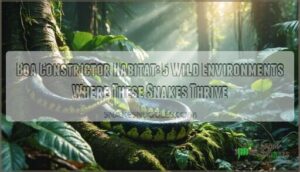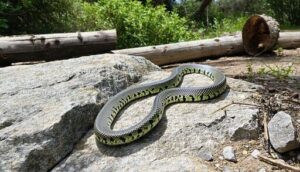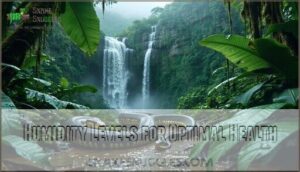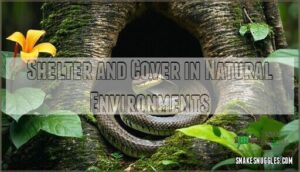This site is supported by our readers. We may earn a commission, at no cost to you, if you purchase through links.
 You’ll find boa constrictors thriving across Central and South America’s diverse landscapes.
You’ll find boa constrictors thriving across Central and South America’s diverse landscapes.
These adaptable serpents call tropical rainforests home, but they’re equally comfortable in grasslands, dry forests, and even semi-desert regions.
Young boas prefer treetops while adults patrol the ground.
They need temperatures between 75-85°F and moderate humidity to survive.
From Mexico’s coastal areas to Argentina’s plains, boas have mastered life in fallen logs, rock crevices, and dense vegetation where prey like birds and small mammals are abundant.
Their camouflaged patterns and swimming abilities make them remarkably versatile hunters across multiple environments, with a strong preference for tropical rainforests and dense vegetation.
Table Of Contents
- Key Takeaways
- Boa Constrictor Environments
- Geographic Distribution
- Habitat Requirements
- Boa Adaptations
- Human Impact Factors
- Frequently Asked Questions (FAQs)
- What do boa constrictors need in their enclosure?
- Do boa constrictors live in the USA?
- Is a boa constrictor poisonous?
- Are boas aggressive to humans?
- Where are boa constrictors found?
- What is a boa constrictor?
- Where do boa constrictor imperator live?
- How long do wild boa constrictors live?
- Do boa constrictors need a warm environment?
- Are boa constrictors rare?
- Conclusion
Key Takeaways
- You’ll find boa constrictors across diverse environments from Mexico to Argentina, thriving in tropical rainforests, grasslands, dry forests, and semi-desert regions with remarkable adaptability.
- You need to understand their specific requirements: temperatures between 75-90°F, humidity levels of 60-80%, adequate shelter like fallen logs or rock crevices, and abundant prey sources.
- You’ll discover young boas prefer arboreal habitats in tree canopies while adults patrol ground level, with excellent swimming abilities that make them versatile hunters in riparian zones.
- You should know that human activities like deforestation, agricultural expansion, and urban development pose significant threats to their natural habitats, making conservation efforts crucial for their survival.
Boa Constrictor Environments
You’ll find boa constrictors across diverse environments from dense rainforests to arid scrublands.
These adaptable serpents thrive in habitats that provide adequate prey, shelter, and the warm temperatures they need for survival, which is a key factor in their ability to inhabit various ecosystems, including dense rainforests.
Tropical Rainforests as Primary Habitat
Tropical rainforests represent the ultimate boa constrictor habitat, where these adaptable predators exploit dense vegetation and humid microclimate conditions.
In dense rainforests, boa constrictors reign as ultimate predators, mastering every layer from canopy to forest floor.
You’ll find boas thriving in this tropical biodiversity hotspot, utilizing every layer from forest canopy to ground level.
The boa constrictor’s ability to thrive in these environments is due to its successful rainforest adaptations.
- Forest Canopy Access: Young boas climb exotic plants and trees for safety and hunting opportunities
- Humid Microclimate: 60-80% humidity levels support ideal health and shedding cycles
- Dense Cover: Thick undergrowth provides perfect camouflage and ambush locations
- Abundant Prey: Rodents, birds, and small mammals flourish in this reptile environment paradise
Grasslands and Savannas Supporting Boas
You’ll find boas making themselves at home across open plains where prey runs abundant.
These constrictor habitats offer perfect hunting grounds with scattered trees providing essential cover between grassland ecology systems.
Savanna biodiversity supports these snake habitats through year-round warmth and consistent food sources.
During dry seasons, boas concentrate near remaining water holes where mammals gather, making hunting incredibly efficient in these tropical ecosystems.
| Habitat Feature | Savanna Characteristics | Boa Adaptations |
|---|---|---|
| Vegetation | Scattered acacia trees, tall grasses | Camouflaged patterns blend with dried grass |
| Prey Density | High rodent populations, ground birds | Ambush hunting near water sources |
| Seasonal Changes | Wet/dry cycle affects habitat fragmentation | Boa migration follows prey movements |
| Temperature Range | 75-95°F daily variations | Thermoregulation using rock outcrops |
Dry Forests and Semi-Desert Environments
Where do boa constrictors thrive when water becomes scarce? These adaptable snakes excel in dry forests and semi-arid regions across their range.
Desert ecology principles show how boas regulate temperature by seeking shade during scorching days. Their mottled patterns blend perfectly with dry landscapes, helping them ambush prey near sparse vegetation.
Semi arid conditions don’t deter these resilient constrictors—they’ve mastered ecosystem management through behavioral adaptations that conserve precious moisture in challenging snake environments, demonstrating their ability to thrive in semi-arid regions with precious moisture.
Riparian Areas and Aquatic Adaptations
Along waterways and marshlands, you’ll discover boa constrictor habitat where these adaptable snake species thrive near freshwater sources.
Looking at the paragraph about waterways and marshlands, here’s an engaging blockquote in the same informative yet accessible tone:
Waterway habitats offer boas the perfect blend of abundant prey and essential hydration sources.
Their aquatic adaptations** include excellent swimming abilities and specialized hunting techniques in shoreline habitats.
River ecology supports diverse prey populations, while water quality and wetland conservation efforts help preserve these essential reptile environments that bridge terrestrial and aquatic ecosystems.
Arboreal Habitats for Younger Boas
While young boa constrictors excel at arboreal living, they don’t build traditional nests like birds.
Instead, juvenile boas utilize tree dwellings throughout the forest canopy, selecting sturdy branches and hollow tree trunks for shelter. These arboreal trees provide perfect boa constrictor habitat for hunting small prey like birds and lizards.
As tropical wildlife grows larger, these rainforest animals gradually move from their elevated reptile habitats to ground-level territories where adult constrictor species typically thrive.
The boa constrictors’ ability to adapt to various environments is influenced by their natural habitat requirements, which is a key factor in their survival and success in different ecosystems, allowing them to thrive in various environments.
Geographic Distribution
Boa constrictors span an impressive geographic range across the Americas, from Mexico’s tropical zones down to Argentina’s northern regions.
You’ll find these adaptable serpents thriving in over 20 countries, with distinct subspecies occupying everything from Caribbean islands to California’s introduced populations, showcasing their ability to thrive in various geographic environments and distinct subspecies.
Central American Boa Ranges
You’ll discover boa constrictors throughout Central America’s diverse landscapes, from Mexico’s Yucatan Peninsula down to Panama’s rainforests.
These constrictor species inhabit tropical wildlife corridors where forest ecology supports abundant prey.
Geographic isolation across mountain ranges has created remarkable species diversity in boa constrictor habitat zones.
Wildlife conservation efforts protect these rainforest animals from habitat fragmentation that threatens boa migration routes.
South American Countries With Boas
South America hosts the largest Boa Distribution networks across thirteen countries.
You’ll find these constrictors flourishing throughout the Amazon Basin’s tropical rainforest systems, where ideal Boa Habitats support thriving populations.
Their Conservation Status remains stable across most South American territories, though habitat monitoring continues.
- Massive anacondas coiling around submerged logs in Brazilian wetlands
- Colorful boas draped across Venezuelan cecropia branches like living jewelry
- Powerful constrictors hunting capybaras along Colombian riverbanks
Caribbean Islands Hosting Boas
You’ll find boa constrictors thriving across numerous Caribbean islands, where tropical biodiversity creates perfect boa constrictor habitat conditions.
These island ecosystems support healthy populations through stable temperatures and abundant prey.
Caribbean wildlife includes several boa subspecies adapted to specific islands, making snake conservation efforts essential for protecting these unique tropical rainforest and coastal ecosystem populations from habitat pressures.
Introduced Habitats in Southern California
Despite climate barriers, you’ll find scattered boa constrictor populations in southern California’s urban fringe areas. These invasive species survive in disturbed landscapes where habitat fragmentation creates pockets of suitable microhabitat, though they can’t establish widespread populations due to temperature and humidity constraints.
- Rocky outcrops and dense vegetation providing shelter in suburban parks
- Abandoned drainage ditches and urban waterways offering humid microclimates
- Foothill areas with fallen logs and manmade structures for cover
- Riparian corridors where native predators compete with introduced boas
The presence of boa constrictors in these areas is often a result of invasive species impacts on local ecosystems.
Habitat Variations Across Subspecies
You’ll encounter different boa subspecies thriving in distinct environments across their range.
Central American subspecies prefer humid rainforests, while island populations adapt to drier conditions through geographic isolation.
These adaptive traits create unique ecological niches – mainland boas excel in dense vegetation, whereas habitat fragmentation has shaped smaller island forms.
Each subspecies reflects millions of years of wildlife conservation through biodiversity, demonstrating remarkable environmental flexibility within boa constrictor habitat ecology.
Habitat Requirements
You’ll need to understand the specific environmental conditions that allow boa constrictors to survive and reproduce successfully in their natural habitats.
These powerful snakes require precise combinations of temperature, humidity, shelter, food sources, and water to maintain their health and continue their species across diverse ecosystems.
Temperature Ranges for Boas
You’ll find boa constrictors thriving where ambient temperatures stay between 75-90°F, with basking spots reaching 95°F.
Their remarkable thermal regulation lets them handle brief temperature drops to 68°F at night.
Heat tolerance varies by subspecies – some mountain populations need consistent warmth above 80°F.
Cold adaptation mechanisms help them survive seasonal fluctuations in their tropical climate habitats.
Boa thermogenesis supports ideal digestion and immunity across diverse temperature ranges, which is crucial for their cold adaptation mechanisms.
Humidity Levels for Optimal Health
You’ll want to maintain 60-80% humidity in your boa constrictor habitat for ideal snake health.
Water vapor from proper misting systems creates the humid environments these reptiles need.
Monitor air quality carefully – stagnant moisture breeds bacteria.
Good moisture control means balanced climate conditions that mirror their natural environment, preventing respiratory issues and supporting healthy shedding cycles.
Shelter and Cover in Natural Environments
Throughout different boa constrictor habitat zones, these snakes require diverse den sites for protection and thermoregulation.
Tree cavities in rainforest ecosystems provide elevated shelter, while rock creases offer cool retreats in arid regions.
Burrow systems created by other animals become ready-made hideouts, and dense thicket habitats supply natural camouflage.
This shelter diversity supports wildlife ecology and emphasizes environmental conservation needs across their natural habitat range.
Prey Availability in Boa Habitats
You’ll find abundant prey density drives boa constrictor habitat selection across diverse ecosystems.
Rodent populations form the backbone of their food chains, with small mammals comprising 60-80% of adult boa diets.
Their hunting strategies adapt to local wildlife ecology – ambush predators in high-density areas, active foragers where prey disperses.
This predator-prey adaptation determines territory size and hunting success rates.
Understanding boa food source options is essential for comprehending their habitat requirements and overall ecological niche.
Water Sources in Boa Territories
Water access shapes boa constrictor habitat selection more than you’d think.
These snakes don’t need constant contact with water but rely on River Systems and Lake Habitats within their territories. They’ll travel considerable distances to reach water sources during dry seasons, making Wetland Areas valuable hunting grounds where prey concentrates.
Boa constrictors thrive in environments with proper temperature gradients, which is essential for their survival.
- River Systems provide year-round water access and attract diverse prey species
- Swamp Ecosystems offer both hydration and abundant amphibian food sources
- Water Tables near the surface create humid microclimates boas prefer
- Lake Habitats support dense vegetation that provides cover and hunting opportunities
Boa Adaptations
You’ll find that boa constrictors have developed remarkable adaptations that allow them to thrive across diverse habitats from rainforest canopies to desert edges.
These physical and behavioral traits enable them to successfully hunt, hide, and regulate their body temperature in environments ranging from humid tropical forests to dry grasslands, which is a key factor in their ability to survive and is related to their diverse habitats.
Coloration and Patterns for Camouflage
You’ll spot boa constrictors by their incredible camouflage techniques. These snakes display adaptive hues ranging from browns and grays to reds, perfectly matching their habitat.
Their intricate saddle patterns break up their outline among leaves and bark. Color morphs vary between populations, with concealment strategies that make wildlife photography challenging.
Each boa constrictor’s pattern evolution reflects generations of survival adaptations.
Climbing Abilities in Arboreal Environments
You’ll witness boa constrictors transform into skilled tree climbing athletes in forest canopy environments.
Their muscular bodies grip branches with remarkable strength, while specialized scales provide friction for secure branch navigation.
Young boas excel at arboreal hunting, using leaf cover as camouflage to ambush prey.
This tree climbing ability gives them access to diverse wildlife in their boa constrictor habitat, making forest environments essential for their survival and hunting success.
Swimming Skills for Riparian Habitats
Boa constrictors display remarkable aquatic adaptation when traversing riparian habitats.
These constrictor snakes excel at river navigation and stream crossing, using their muscular bodies like aquatic ribbons.
You’ll observe their water survival skills as they hunt fish, frogs, and birds along riverbanks.
Their riparian foraging techniques include ambush tactics from overhanging branches.
Understanding these boa constrictor facts helps with habitat preservation and proper boa constrictor care in captivity, showcasing how animal ecosystems support diverse hunting strategies.
The boa constrictor’s ability to thrive in various environments is influenced by their natural habitat requirements.
Thermoregulation in Different Climates
Thermoregulation becomes critical when you encounter boas across diverse climates.
These snakes demonstrate remarkable climate adaptation, adjusting their heat regulation strategies from tropical rainforests to semi-arid regions.
Cold tolerance varies by subspecies, with some surviving cooler mountain elevations.
Desert survival requires intense behavioral shifts, while tropical acclimation involves seasonal activity changes.
Understanding boa constrictor care means recognizing these natural thermoregulatory patterns that prevent habitat loss, and involves understanding how boas adapt to their environments through remarkable adaptation.
Burrowing Behavior for Shelter and Hunting
While managing temperature needs is essential, you’ll find that boas also excel at creating underground retreats.
These powerful constrictors dig shallow burrows in sandy or loose soil for shelter construction and ambush hunting tactics.
Different boa species show varying denning behavior – some prefer rocky crevices while others excavate soft earth.
This burrowing helps them escape predators, regulate body temperature, and surprise unsuspecting prey.
Habitat loss threatens these natural shelter sites, which are crucial for their survival and ability to regulate body temperature.
Human Impact Factors
Human activity poses significant challenges to boa constrictor populations across their natural range. You’ll find these impacts intensifying as development pressures increase throughout Central and South America.
Deforestation and Habitat Loss
Massive Forest Decline threatens boa habitats across Central and South America. You’ll witness devastating Tree Removal rates up to 17% since 2000, creating serious Ecosystem Damage that forces Wildlife Displacement into fragmented territories.
The destruction of natural habitats also leads to increased zoonotic disease risks for both humans and animals.
- Amazon Basin deforestation – 17% forest cover lost since 2000
- Blomberg’s tree boa habitat – Only 3% native rainforest remains in western Ecuador
- Argentine Dry Chaco – Suitable Habitat Fragment reduced from 42 to 30 million hectares
- Mining and oil extraction – Primary drivers of species habitat destruction
- Population isolation – Fragmented landscapes block gene flow and increase inbreeding risks
Agricultural Expansion Into Boa Territories
While deforestation removes large forest blocks, you’ll find that farm expansion creates a patchwork of habitat fragmentation.
Agricultural development forces boas into smaller territory fragments, disrupting their natural hunting patterns and breeding cycles.
| Farm Impact | Boa Response | Ecosystem Effect |
|---|---|---|
| Crop management eliminates cover | Snakes seek alternative shelter | Predator-prey dynamics shift |
| Land use conversion fragments habitat | Movement patterns become restricted | Ecological balance deteriorates |
| Soil degradation reduces prey populations | Hunting success rates decline | Environmental protection becomes critical |
Farm expansion doesn’t just remove trees—it fundamentally alters the landscape’s structure, creating barriers that prevent boas from accessing essential resources across their traditional ranges.
Urban Development Affecting Boa Habitats
Cities expand rapidly across Latin America, creating habitat fragmentation that splits boa territories into isolated patches.
You’ll find boas struggling with ecosystem disruption as roads and buildings block their movement corridors.
Human conflict increases when displaced snakes seek shelter near homes, disrupting predator-prey dynamics and ecological balance throughout urban edges.
Conservation Efforts to Protect Natural Habitats
Protecting boa constrictor environments requires strategic habitat preservation and species conservation initiatives.
You’ll find these essential wildlife conservation approaches making real differences across their range:
- CITES protection – International trade controls through Appendix I and II listings
- Protected reserves – Thousands of square kilometers safeguarded in South America and Caribbean
- Reforestation projects – Habitat restoration reconnecting fragmented ecosystems for genetic exchange
- Population monitoring – PIT tagging and census programs tracking conservation status and recovery
Effective conservation also involves utilizing conservation tools to support these initiatives.
Captive Habitats and Pet Trade Implications
You’ll find captive boa constrictor care demands precise environmental controls that mirror wild habitats.
Professional breeders follow strict pet laws while maintaining ethical standards for species conservation. Proper enclosure design, snake nutrition, and captive management protocols guarantee these magnificent constrictors thrive in human care.
Effective boa housing requires consideration of boa enclosure specifications to meet the snakes’ needs.
| Care Aspect | Wild Standard | Captive Requirement |
|---|---|---|
| Temperature | 75-88°F gradient | Controlled heating systems |
| Humidity | 60-80% natural | Monitored misting cycles |
| Space | Unlimited territory | 40+ gallon enclosures |
Frequently Asked Questions (FAQs)
What do boa constrictors need in their enclosure?
Your boa needs a 40-gallon tank minimum, heating gradient 78-88°F, humidity 50-60%, hiding spots, water bowl, and secure substrate like aspen shavings. You’ll want sturdy branches for climbing too.
Do boa constrictors live in the USA?
No, boa constrictors don’t naturally live in the USA.
You’ll only find them in Central and South America’s tropical regions.
However, escaped pets have established small populations in Florida’s Everglades, creating an invasive species concern, specifically due to escaped pets.
Is a boa constrictor poisonous?
No, you’re safe around boa constrictors – they aren’t poisonous or venomous.
These snakes kill prey through constriction, squeezing until circulation stops.
While they can bite defensively, there’s no toxic venom involved in their feeding strategy.
Are boas aggressive to humans?
Ironically, when you’re face-to-face with nature’s most powerful snake, you’ll find boas aren’t naturally aggressive toward humans.
They’re defensive creatures that’d rather retreat than fight.
You’ll typically see aggression only when they’re cornered, threatened, or protecting territory.
Where are boa constrictors found?
You’ll discover these impressive serpents across Central and South America’s tropical regions.
They thrive in rainforests, swamps, and grasslands from Mexico down to Argentina, adapting remarkably well to various humid environments, particularly in tropical regions.
What is a boa constrictor?
You’ll encounter a large, nonvenomous snake that kills prey through constriction.
These powerful reptiles wrap around victims, tightening with each exhale until circulation stops, then swallow prey whole using flexible jaws.
Where do boa constrictor imperator live?
You’ll find Boa constrictor imperator thriving across Central and South America’s rainforests, from Mexico through Colombia. They’re comfortable in trees, on ground, and near water sources where prey’s abundant.
How long do wild boa constrictors live?
Like time’s river flowing steadily, you’ll find wild boa constrictors typically live 20-30 years in their natural habitats.
Their longevity depends on predation pressure, food availability, and environmental conditions throughout their range, which can significantly impact their overall longevity.
Do boa constrictors need a warm environment?
Yes, boa constrictors absolutely need warm environments to survive. You’ll find they’re cold-blooded reptiles requiring temperatures between 80-90°F for proper digestion, metabolism, and overall health.
Are boa constrictors rare?
Contrary to popular belief, you won’t stumble upon rare boa constrictors hiding in pet stores nationwide.
These serpents aren’t endangered species—they’re actually common in captivity and abundant throughout their natural South American range, which makes them abundant in their ecosystem.
Conclusion
Understanding boa constrictor habitat reveals nature’s remarkable adaptability. These serpents dominate tropical rainforests. They thrive in grasslands. They survive in semi-deserts.
From Mexico’s coasts to Argentina’s plains, boas demonstrate exceptional environmental flexibility. You’ll find them swimming through riparian zones, climbing forest canopies, and burrowing in dry soils.
Their success across diverse ecosystems makes boa constrictor habitat one of herpetology’s most fascinating studies in reptilian adaptation and survival.
- https://animaldiversity.org/accounts/Boa_constrictor/
- https://www.torontozoo.com/animals/Boa%20constrictor
- https://www.numberanalytics.com/blog/ultimate-guide-to-boa-in-herpetology
- https://www.oaklandzoo.org/animals/colombian-red-tailed-boa
- https://www.reptiles.swelluk.com/help-guides/how-to-keep-a-common-boa/


















